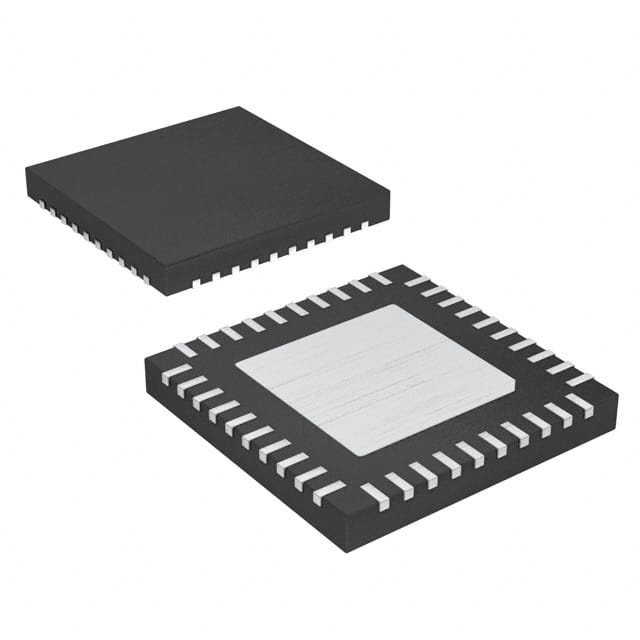R5F213M8QNNP#U0
Basic Information Overview
- Category: Microcontroller
- Use: Embedded systems, IoT devices, consumer electronics
- Characteristics: Low power consumption, high performance, small form factor
- Package: QFP (Quad Flat Package)
- Essence: Control and processing unit for electronic devices
- Packaging/Quantity: Individual units or reels of multiple units
Specifications
- Architecture: 16-bit CISC
- CPU Speed: Up to 20 MHz
- Flash Memory: 256 KB
- RAM: 16 KB
- Operating Voltage: 2.7 V to 5.5 V
- I/O Pins: 48
- Communication Interfaces: UART, SPI, I2C
- Timers/Counters: 4
- Analog-to-Digital Converter (ADC): 10-bit, 8 channels
- PWM Channels: 8
- Operating Temperature Range: -40°C to +85°C
Detailed Pin Configuration
The R5F213M8QNNP#U0 microcontroller has a total of 48 pins. The pin configuration is as follows:
- VDD
- P00
- P01
- P02
- P03
- P04
- P05
- P06
- P07
- P10
- P11
- P12
- P13
- P14
- P15
- P16
- P17
- P20
- P21
- P22
- P23
- P24
- P25
- P26
- P27
- P30
- P31
- P32
- P33
- P34
- P35
- P36
- P37
- P40
- P41
- P42
- P43
- P44
- P45
- P46
- P47
- RESET
- XT1IN
- XT1OUT
- VSS
- AVREF
- AIN0
- AIN1
Functional Features
- Low power consumption for energy-efficient applications
- High-performance CPU for fast data processing
- Multiple communication interfaces for connectivity options
- Analog-to-Digital Converter for sensor interfacing
- PWM channels for precise control of output signals
- Timers/Counters for timekeeping and event triggering
Advantages and Disadvantages
Advantages: - Low power consumption extends battery life in portable devices - High-performance CPU enables efficient execution of complex tasks - Multiple communication interfaces provide flexibility in system integration - Analog-to-Digital Converter allows for accurate measurement of analog signals - PWM channels enable precise control of output signals
Disadvantages: - Limited flash memory and RAM compared to higher-end microcontrollers - Limited number of I/O pins may restrict the number of peripherals that can be connected
Working Principles
The R5F213M8QNNP#U0 microcontroller operates based on a 16-bit CISC architecture. It executes instructions stored in its flash memory, processes data, and controls the operation of connected devices through its I/O pins. The CPU communicates with external devices using various communication interfaces such as UART, SPI, and I2C. It also includes timers/counters for timekeeping and event triggering, an ADC for analog signal conversion, and PWM channels for precise control of output signals.
Detailed Application Field Plans
The R5F213M8QNNP#U0 microcontroller is suitable for a wide range of applications, including:
- Embedded Systems: Used as the control unit in various embedded systems such as industrial automation, home automation, and automotive electronics.
- IoT Devices: Enables connectivity and control in IoT devices like smart home devices, wearable technology, and environmental monitoring systems.
- Consumer Electronics: Powers consumer electronic devices such as remote controls, gaming consoles, and audio/video equipment.
Detailed and Complete Alternative Models
- R5F213M8SDFP#U0: Similar to R5F213M8QNNP#U0 but in a different package (LQFP).
- R5F213M8SNFP#U0: Similar to R5F213M8QNNP#U0 but with additional features and higher memory capacity.
- R5F213M8TDFP#U0: Similar to R5F213M8QNNP#U0 but with extended temperature range.
These alternative models offer similar functionality and can be considered based on specific project requirements.
*Note: The content provided
Senaraikan 10 soalan dan jawapan biasa yang berkaitan dengan aplikasi R5F213M8QNNP#U0 dalam penyelesaian teknikal
Sure! Here are 10 common questions and answers related to the application of R5F213M8QNNP#U0 in technical solutions:
Question: What is the R5F213M8QNNP#U0 microcontroller used for?
Answer: The R5F213M8QNNP#U0 microcontroller is commonly used in various technical solutions, including industrial automation, consumer electronics, and automotive applications.Question: What is the maximum clock frequency supported by the R5F213M8QNNP#U0?
Answer: The R5F213M8QNNP#U0 microcontroller supports a maximum clock frequency of 20 MHz.Question: How much flash memory does the R5F213M8QNNP#U0 have?
Answer: The R5F213M8QNNP#U0 microcontroller has 64 KB of flash memory for program storage.Question: Can I expand the memory of the R5F213M8QNNP#U0?
Answer: No, the R5F213M8QNNP#U0 does not support external memory expansion. However, it does have 4 KB of RAM for data storage.Question: What peripherals are available on the R5F213M8QNNP#U0?
Answer: The R5F213M8QNNP#U0 microcontroller features multiple UARTs, SPI, I2C, ADC, timers, and GPIO pins for interfacing with various devices and sensors.Question: Does the R5F213M8QNNP#U0 support real-time operating systems (RTOS)?
Answer: Yes, the R5F213M8QNNP#U0 is compatible with popular RTOSs like FreeRTOS, allowing for efficient multitasking and real-time applications.Question: What development tools are available for programming the R5F213M8QNNP#U0?
Answer: Renesas provides a comprehensive development environment called e² studio, which includes a C/C++ compiler, debugger, and various software libraries for the R5F213M8QNNP#U0.Question: Can I use the R5F213M8QNNP#U0 for motor control applications?
Answer: Yes, the R5F213M8QNNP#U0 supports pulse-width modulation (PWM) outputs, making it suitable for motor control applications.Question: Is the R5F213M8QNNP#U0 microcontroller low power?
Answer: Yes, the R5F213M8QNNP#U0 features multiple low-power modes, allowing for efficient power management in battery-powered applications.Question: Are there any evaluation boards available for the R5F213M8QNNP#U0?
Answer: Yes, Renesas offers an evaluation board specifically designed for the R5F213M8QNNP#U0 microcontroller, providing a convenient platform for development and testing.
Please note that the specific details and answers may vary depending on the manufacturer's documentation and specifications of the R5F213M8QNNP#U0 microcontroller.


